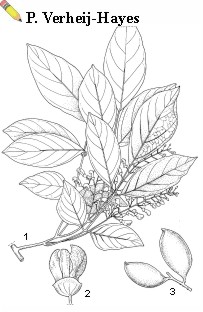Record Number
1202
PROSEA Handbook Number
12(2): Medicinal and poisonous plants 2
Taxon
Millettia pinnata (L.) Panigrahi
This article should be read together with the article on the genus: Millettia in the Handbook volume indicated above in this database.
This article should be read together with the article on the genus: Millettia in the Handbook volume indicated above in this database.
Protologue
in G. Panigrahi & S.K. Murti, Fl. Bilaspur Distr. 1: 210 (1989).
Synonyms
Pongamia pinnata (L.) Pierre (1899), Millettia novo-guineensis Kanehira & Hatusima (1942), Derris indica (Lamk) J.J. Bennett (1971).
Vernacular Names
Pongam, Indian beech (En). Pongame oil tree (Am). Arbre de pongolote (Fr). Indonesia: bangkong (Javanese), ki pahang laut (Sundanese), kranji (Madurese). Malaysia: mempari, kacang kayu laut (Peninsular), biansu (Sarawak). Philippines: bani (general), balikbalik, balok (Tagalog). Laos: (do:k) ko:m ko:y. Thailand: khayi, yi-nam (peninsular). Vietnam: d[aa]y m[aas]u, d[aa]y lim, kh[oor] s[aa]m hoa.
Distribution
Millettia pinnata occurs naturally or locally naturalized from Pakistan, India and Sri Lanka throughout South-East Asia to north-eastern Australia, Fiji and Japan. It has been introduced in Egypt and the United States (Florida, Hawaii).
Uses
Extracts from the leaves, bark and seed are applied as antiseptic against skin diseases and rheumatism. Pounded and roasted seeds can be used as a fish poison. In rural areas, dried leaves are stored with grain to repel insects. The seed-oil is applied as a lubricant, as a leather dressing in the traditional Indian tanning industry, and in manufacturing soap, varnish and paint. The leaves, flowers and seed-cake are used as green manure; the leaves and seed-cake also as fodder. The wood is used for temporary shelters, and twigs are occasionally used as a toothbrush. In India, Millettia pinnata is used as a host of the lac insect and of the hemiparasite sandalwood Santalum album L. It is occasionally planted as an ornamental because of its attractive flowers.
Observations
An evergreen or briefly deciduous, glabrous shrub or tree with spreading branches, 15—25 m tall, trunk up to 80 cm in diameter; leaflets 5—9, ovate, elliptical or oblong, 5—25 cm x 2.5—15 cm, base rounded to cuneate, apex obtuse-acuminate; inflorescence pseudoracemose, axillary, 6—27 cm long, each node bearing a pair of strongly fragrant flowers; calyx campanulate, 4—5 mm long, truncate, finely pubescent, corolla white to pink, purple inside, often with green central blotch, brownish veined outside, standard rounded obovate, 1—2 cm long, with basal callosities, thinly silky hairy, wings oblong, oblique, slightly adherent to obtuse keel, stamens monadelphous, vexillary one free at base, joined to the tube in the middle; pod oblique-oblongoid to ellipsoid, flat, 5—8 cm x 2—3.5 cm x 1—1.5 cm, smooth, thick-leathery to subwoody, beaked, short-stalked, tardily dehiscent, 1—2-seeded, mesocarp fibrous; seed compressed ovoid, 1.5—2.5 cm x 1.2—2 cm x 0.8 cm, with a brittle coat. Millettia pinnata occurs on a wide range of soils in lowland forest on limestone and rocky coral outcrops on the coast, along the edges of mangrove forest and along tidal streams and rivers from sea-level up to 1200 m altitude. Pods may be transported by sea currents, but germination takes place in non-saline conditions.
Image
 | Millettia pinnata (L.) Panigrahi - 1, flowering branch; 2, flower; 3, pods |
Selected Sources
[74] Backer, C.A. & Bakhuizen van den Brink Jr, R.C., 1964—1968. Flora of Java. 3 volumes. Noordhoff, Groningen, the Netherlands. Vol. 1 (1964) 647 pp., Vol. 2 (1965) 641 pp., Vol. 3 (1968) 761 pp.
[295] Faridah Hanum, I. & van der Maesen, L.J.G. (Editors), 1997. Plant Resources of South-East Asia No 11. Auxiliary plants. Backhuys Publishers, Leiden, the Netherlands. 389 pp.
[1038] Verdcourt, B., 1979. A manual of New Guinea legumes. Botany Bulletin No 11. Office of Forests, Division of Botany, Lae, Papua New Guinea. 645 pp.
[295] Faridah Hanum, I. & van der Maesen, L.J.G. (Editors), 1997. Plant Resources of South-East Asia No 11. Auxiliary plants. Backhuys Publishers, Leiden, the Netherlands. 389 pp.
[1038] Verdcourt, B., 1979. A manual of New Guinea legumes. Botany Bulletin No 11. Office of Forests, Division of Botany, Lae, Papua New Guinea. 645 pp.
Author(s)
J.L.C.H. van Valkenburg
Correct Citation of this Article
van Valkenburg, J.L.C.H., 2001. Millettia pinnata (L.) Panigrahi. In: van Valkenburg, J.L.C.H. and Bunyapraphatsara, N. (Editors): Plant Resources of South-East Asia No 12(2): Medicinal and poisonous plants 2. PROSEA Foundation, Bogor, Indonesia. Database record: prota4u.org/prosea

All texts are licensed under a Creative Commons Attribution-Noncommercial-Share Alike 3.0 Netherlands License
This license does not include the illustrations (Maps,drawings,pictures); these remain all under copyright.